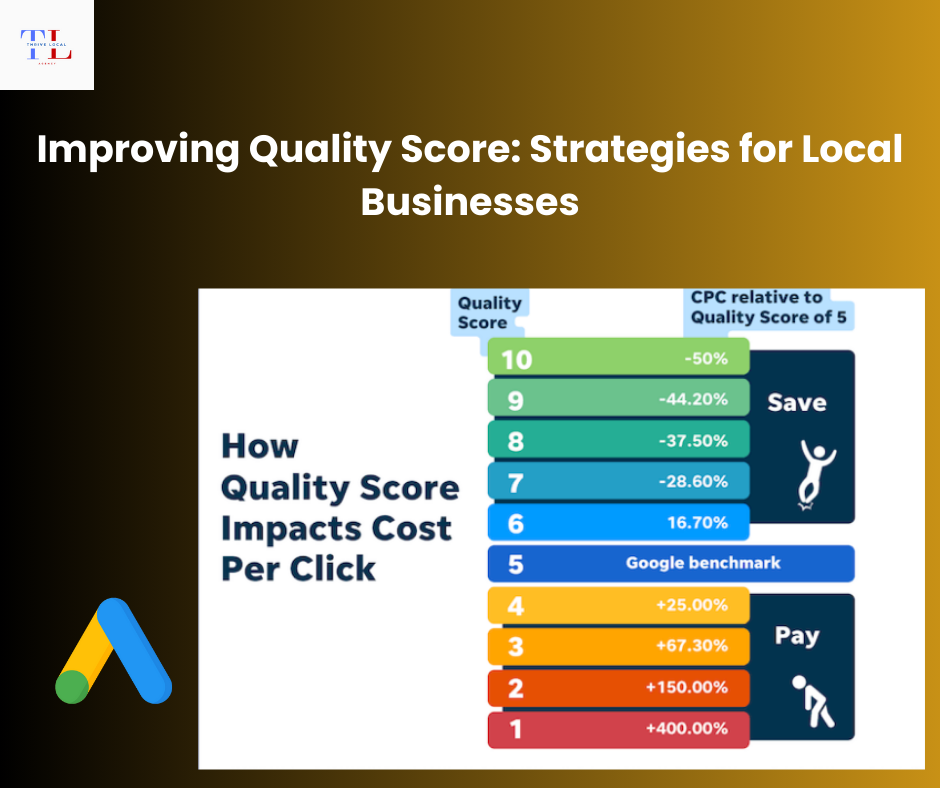For local businesses utilizing Google Ads, understanding and optimizing Quality Score is crucial for enhancing ad performance and maximizing return on investment. This comprehensive guide delves into the nuances of Quality Score, its significance, actionable strategies for improvement, expected timelines for changes, and key performance indicators (KPIs) to monitor.
What Is Quality Score?
Quality Score is a metric used by Google Ads to evaluate the relevance and quality of your keywords, ads, and landing pages. It is rated on a scale from 1 to 10, with 10 being the highest. A higher Quality Score indicates that your ad and landing page are more relevant and useful to someone searching for your keyword. This score directly influences your ad’s position (Ad Rank) and the cost per click (CPC). A higher Quality Score can lead to better ad placements at lower costs.
Why Quality Score Matters for Local Businesses
- Cost Efficiency: Higher Quality Scores can lead to lower CPCs, allowing more clicks within the same budget.
- Improved Ad Positions: Ads with better Quality Scores are more likely to appear in top positions, increasing visibility.
- Enhanced User Experience: Relevant ads and landing pages provide a better experience for users, increasing the likelihood of conversions.
Strategies to Improve Quality Score
1. Enhance Expected Click-Through Rate (CTR)
The expected CTR is an estimate of how likely your ad is to be clicked when shown. To improve this:Google Help+5Google Help+5SEMrush+5
- Craft Compelling Ad Copy: Use clear, concise language with strong calls-to-action. Example: Instead of “We offer plumbing services,” use “Need a plumber fast? Call us 24/7 for emergency plumbing!”
- Utilize Ad Extensions: Incorporate sitelinks, callouts, and structured snippets to provide additional information and increase ad real estate.
2. Improve Ad Relevance
Ad relevance measures how closely your ad matches the intent behind a user’s search. To enhance this:SEMrush+3Google Help+3Wikipedia+3
- Align Keywords with Ad Text: Ensure that your ad copy closely matches the keywords in each ad group. Example: If your keyword is “emergency dentist,” your ad headline could be “24/7 Emergency Dental Services Available Now.”
- Use Thematic Ad Groups: Group similar keywords together to create more targeted ad copy. Example: For a bakery, separate ad groups for “wedding cakes,” “birthday cakes,” and “cupcakes” allow for more specific ads.
- Consider Testing SKAGs (Single Keyword Ad Groups): While SKAGs involve creating ad groups with a single keyword to tightly align ads and keywords, they can be time-consuming and may not always yield better results due to Google’s evolving algorithms. It’s advisable to test SKAGs in specific scenarios to determine their effectiveness for your business. Jyll’s Ad Courses
3. Optimize Landing Page Experience
The landing page experience assesses how relevant and useful your landing page is to people who click your ad. To improve this:Google Help
- Ensure Content Relevance: The landing page should directly relate to the ad’s offer and keywords. Example: If your ad promotes “free home insulation estimates,” the landing page should prominently feature information about the free estimates, not general insulation services.
- Improve Page Load Speed: Faster-loading pages enhance user experience and reduce bounce rates.
- Mobile Optimization: Ensure that landing pages are responsive and function well on mobile devices, as a significant portion of users access websites via smartphones.
- Clear Call-to-Action (CTA): Make it easy for users to take the desired action, such as filling out a form or calling your business.
4. Refine Keyword Selection
Choosing the right keywords is foundational to your ad’s success. To refine your selection:
- Use Negative Keywords: Exclude irrelevant search terms to prevent wasted spend. Example: If you offer premium landscaping services, you might add “cheap” as a negative keyword to avoid attracting bargain hunters.
- Conduct Regular Keyword Research: Identify new, relevant keywords and remove underperforming ones.Reddit
- Focus on Long-Tail Keywords: These are more specific and often indicate higher purchase intent. Example: Instead of targeting “dentist,” use “emergency pediatric dentist in Milton.”Medium+1Jyll’s Ad Courses+1
5. Structure Your Account Effectively
A well-structured account facilitates better ad relevance and performance. To achieve this:
- Organize Campaigns Logically: Group similar products or services together. Example: A home services company might have separate campaigns for plumbing, electrical, and HVAC services.
- Maintain Consistency: Ensure consistency between keywords, ad copy, and landing pages across each ad group.
- Regularly Review and Adjust: Monitor performance and make necessary adjustments to optimize results.
Timeline for Quality Score Improvements
Quality Score updates are dynamic and depend on various factors, including the frequency of ad impressions and user interactions. Typically, noticeable improvements can occur within a few days to a couple of weeks after implementing changes. However, in some cases, especially with low-traffic keywords, it may take longer to see significant changes.
Key Performance Indicators (KPIs) to Monitor
- Quality Score: Track the Quality Score for each keyword to identify areas needing improvement.
- Click-Through Rate (CTR): Higher CTRs often correlate with better Quality Scores.
- Conversion Rate: Monitor the percentage of clicks that result in desired actions to assess landing page effectiveness.
- Bounce Rate: A high bounce rate may indicate that the landing page content isn’t meeting user expectations.
- Page Load Time: Faster-loading pages contribute to a better user experience and can positively impact Quality Score.
Conclusion
For local businesses, optimizing Quality Score is essential for maximizing the efficiency of Google Ads campaigns. By focusing on ad relevance, improving landing page experiences, refining keyword selection, and continuously monitoring key performance metrics, businesses can achieve better ad placements, lower costs, and higher conversion rates.
If you need further assistance in implementing these strategies or have specific questions about your campaigns, feel free to reach out!

